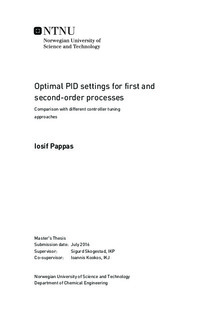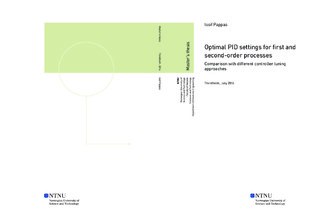| dc.description.abstract | PID controllers are extensively used in industry. Although many tuning methodologies exist, finding good controller settings is not an easy task and frequently optimization-based design is preferred to satisfy more complex criteria. In this thesis, the focus was to find which tuning approaches, if any, present close to optimal behavior.
Pareto-optimal controllers were found for different first and second-order processes with time delay. Performance was quantified in terms of the integrated absolute error, while robustness was defined as the maximum peak of the sensitivity function. Ideal PID controllers were used to create SIMC, K-SIMC and optimal tuning curves. As for the FOPTD, the SIMC performed close to the optimal for the whole robustness region. On the other hand, the K-SIMC settings performed well and outperformed the SIMC at the less robust region. That is due to the fact, that the K-SIMC rules suggest a PI controller for small values of the sensitivity peak. When it comes to the SOPTD, the SIMC and the K-SIMC were almost identical performance-wise. However, when the time delay is relatively small the I-SIMC tunings should be chosen. If higher-order models are required to be approximated as a first or second-order process with time delay, the half rule approximations achieved superior results when compared to the K-SIMC approximations.
Furthermore, SIMC, K-SIMC and optimal controllers were found for a given process and for specified robustness. The K-SIMC rules suggested a PI controller, instead of the PID controllers which were suggested by the other two tuning approaches. The controllers were applied to models, which had slightly different characteristics than the original process. The PI controller handled a wider variety of processes. However, similar results would have been derived for a PI SIMC or for an optimal PI controller.
In addition, two other tuning approaches were investigated. Firstly, the Syrcos & Kookos settings were found and compared with the optimal and the SIMC. The former methodology showcased very satisfactory results, which could be proven to be more beneficial than the SIMC for processes with relatively large time delay. Secondly, the MATLAB Tuning Toolbox was used to find balanced controllers, in terms of performance and robustness. First and second-order processes with varying time delay values were examined. Although the Tuning Toolbox presented acceptable results, it should not be used for small time delay values due to the low proportional gain and the absence of derivative action of the controller.
Finally, optimal, SIMC and K-SIMC controllers were tested on the thermal/optimal plant uDAQ28/LT, where only the temperature was the measured variable. The process was approximated as an integrating process and due to the high input usage and the small compensation from the use of derivative action, a PI controller is the most advantageous available choice. | |

